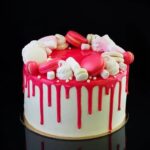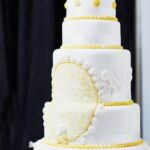Are you looking to learn how to decorate flowers on a cake? Floral decorations have long been an essential part of cake design, adding elegance and beauty to any confection. From traditional floral patterns to modern, innovative designs, the art of decorating cakes with flowers continues to evolve. In this article, we will explore the various techniques, tips, and trends for creating stunning floral cake decorations.
Floral cake decorations have a rich history that dates back centuries. In many cultures, flowers symbolize celebration and are used to adorn special occasions such as weddings, birthdays, and anniversaries. The use of edible flowers for cake decorating has become increasingly popular in recent years, allowing pastry chefs and home bakers to elevate their creations with natural blossoms.
The importance of floral decorations in cake design cannot be overstated. Flowers can enhance the overall aesthetic appeal of a cake and provide a delightful sensory experience for those enjoying it.
Whether using fresh blooms or intricately crafted sugar flowers, the careful selection and arrangement of these delicate elements can transform a simple dessert into a work of art worthy of admiration. Join us as we delve into the world of decorating cakes with flowers and uncover the secrets to creating stunning floral masterpieces.
Types of Edible Flowers for Cake Decorating
When it comes to decorating cakes with flowers, choosing the right edible flowers is essential for a beautiful and safe cake design. Some popular edible flowers commonly used for cake decoration include roses, violets, pansies, lavender, and chamomile. These flowers not only add a delightful visual appeal to the cake but also bring unique flavors and aromas that complement the overall taste experience.
When selecting edible flowers for cake decorating, it’s crucial to ensure that they are safe for consumption and have not been treated with any harmful chemicals. It is best to source these flowers from reputable suppliers or specialty grocery stores where they are labeled specifically for culinary use.
Additionally, it’s important to consider the flavor profile of the flowers and how they will complement the flavors of the cake. For example, delicate floral notes from roses can enhance a vanilla or rose-flavored cake, while citrusy flavors from violets can pair well with lemon or citrus-infused cakes.
Incorporating edible flowers in cake decoration adds a touch of elegance and charm that elevates the overall presentation of the dessert. In addition to aesthetics, edible flowers also contribute to the sensory experience by introducing unique flavors and aromas. With proper selection and care, edible flowers can be a delightful addition to any cake design.
Preparing and Preserving Flowers for Cake Decoration
When it comes to using flowers for decorating cakes, it is important to properly prepare and preserve the flowers to ensure that they are safe for consumption. The first step in preparing edible flowers for cake decoration is to carefully clean them. It is crucial to remove any dirt, debris, or insects from the flowers before using them on a cake. This can be done by gently rinsing the flowers with water and allowing them to air dry.
After cleaning the flowers, it is essential to store them properly to maintain their freshness. One method for preserving edible flowers is by placing them in a damp paper towel and storing them in an airtight container in the refrigerator. This will help keep the flowers hydrated and prevent them from wilting before they are used on the cake.
It’s also important to note that not all flowers are safe for consumption, so it’s crucial to research and identify which varieties are edible before using them as cake decorations. Some popular edible flowers for cake decorating include roses, violets, pansies, and lavender. Additionally, certain types of blossoms such as lilacs should be avoided as they can be toxic if ingested.
| Flower Type | Preparation Method |
|---|---|
| Roses | Clean petals thoroughly with water |
| Violets | Gently rinse with water and pat dry |
| Lavender | Remove stems and gently wash in cold water |
Techniques for Arranging Flowers on Cake
When it comes to arranging flowers on a cake, there are several important techniques to keep in mind. One of the first steps is to ensure that the flowers you are using are edible and safe for consumption. It’s essential to select flowers that have not been treated with pesticides or other chemicals that could be harmful if ingested. Additionally, be sure to thoroughly wash the flowers before use to remove any dirt or potential contaminants.
Once you have selected and prepared your edible flowers, it’s time to consider how you want to arrange them on the cake. Start by determining the overall design and placement of the flowers. Consider whether you want a more structured and symmetrical look or a more organic and natural arrangement.
For a structured design, you may choose to create a floral wreath around the perimeter of the cake or cluster the flowers in specific areas. For a more natural look, consider scattering the flowers loosely across the top of the cake.
After deciding on your arrangement style, carefully place each flower onto the cake. Be gentle when handling delicate petals and try not to press too hard against the frosting. It’s also important to consider balance and visual appeal when arranging the flowers. Create depth by varying the heights of different flowers and strategically placing them around the cake. Pay attention to color patterns as well, making sure that complementary colors are evenly distributed for an aesthetically pleasing result.
| Edible Flower | Tips for Arrangement |
|---|---|
| Roses | Consider removing thorns and using smaller buds for detailed arrangements. |
| Lavender | Use lavender sprigs sparingly for a subtle touch of fragrance and color. |
| Violets | Gently press violets into soft frosting for an elegant appearance. |
Using Fresh Flowers vs Sugar Flowers
When it comes to decorating cakes with flowers, one of the important decisions to make is whether to use fresh flowers or sugar flowers. Each option has its own pros and cons, and understanding them is essential for creating a stunning and safe floral cake design.
Fresh flowers are a popular choice for cake decoration due to their natural beauty and fragrance. They add a touch of elegance and freshness to any cake design. However, it is crucial to ensure that the flowers used are edible and free from pesticides. Furthermore, some people may have allergies to certain types of fresh flowers, so it’s important to consider the preferences and dietary restrictions of your intended audience when choosing to use fresh flowers on cakes.
On the other hand, sugar flowers offer the advantage of being completely edible and free from potential allergens. They can be crafted in advance and stored for long periods of time, making them a convenient choice for elaborate cake designs that require specific flower types or colors. Additionally, sugar flowers allow for complete creative control over the design, as they can be customized to fit any theme or color scheme.
Color Palettes and Complementary Flowers
Choosing the right color palette and complementary flowers is essential for creating a visually stunning cake design. When it comes to decorating cakes with flowers, the colors and flower combinations play a crucial role in achieving a cohesive and harmonious look. Here are some tips for selecting the perfect color palettes and complementary flowers for your cake decorations:
- Consider the theme: Think about the overall theme or occasion for the cake. Whether it’s a wedding, birthday, or other special event, the theme can guide your color choices and flower selections.
- Take inspiration from nature: Look to nature for inspiration when choosing colors and flowers. Consider seasonal blooms and natural color combinations to create a beautiful and organic design.
- Harmonize with the cake design: Take into account the existing design elements of the cake, such as frosting colors or decorative patterns. Select flower colors that complement and enhance the overall look of the cake.
In addition to selecting the right color palette, it’s important to choose complementary flowers that work well together to create an eye-catching arrangement. Here are some popular flower combinations that work well for cake decorating:
- Roses and baby’s breath: This classic combination adds romance and elegance to any cake design.
- Lavender and chamomile: Perfect for a rustic or garden-inspired cake, these delicate flowers pair beautifully together.
- Sunflowers and daisies: For a cheerful and vibrant cake design, consider using these bold blooms in complementary colors.
By carefully selecting your color palette and complementary flowers, you can create a stunning floral display on your cakes that will impress your clients or guests. Experiment with different combinations to discover which ones work best for your unique cake designs. Remember, creating floral decorations should be fun and allow you to showcase your creativity as a baker or decorator.
Incorporating Floral Trends Into Cake Decorating
Current Trends in Floral Cake Decoration
Floral cake decorations have evolved over the years, and current trends reflect a range of styles and techniques. From minimalistic designs with a single focal flower to elaborate cascading arrangements, there are endless possibilities for incorporating floral trends into cake decorating.
Some popular contemporary trends include the use of wildflowers for a rustic, natural look, as well as the incorporation of metallic accents for a modern touch. Additionally, oversized blooms and abstract, artistic arrangements are gaining popularity in the world of floral cake decoration.
Ways to Incorporate Modern Floral Design Elements Into Cake Decorating
One way to incorporate modern floral design elements into cake decorating is by using non-traditional flowers or greenery, such as succulents or tropical foliage, to create unique and eye-catching designs. Another trend is the use of edible flowers in vibrant, unexpected colors to add a bold statement to cakes.
Furthermore, experimenting with asymmetrical arrangements or geometric patterns can give cakes a contemporary and avant-garde look. By staying updated on current floral design trends and drawing inspiration from different sources like fashion and interior design, cake decorators can infuse modernity into their floral creations.
Staying True to Your Style While Embracing Floral Trends
While it’s important to stay informed about current floral trends, it’s equally essential for cake decorators to stay true to their personal style when incorporating these elements into their designs. Whether it’s sticking to a particular color palette or maintaining a signature aesthetic throughout their creations, decorators should aim to seamlessly integrate modern floral influences while still showcasing their own unique creative voice.
Ultimately, embracing floral trends into cake decorating should be an opportunity for artists to expand their horizons and experiment with new ideas while staying authentic to their individual style.
Troubleshooting Common Issues With Floral Cake Decorations
Solutions for Wilting or Discoloration of Flowers
One common issue that may arise when decorating cakes with flowers is the wilting or discoloration of the flowers. To prevent this from happening, it is important to properly prepare the flowers before placing them on the cake. One effective way to prolong the freshness of flowers is by placing them in a vase of water in the refrigerator for a few hours before using them. Additionally, misting the flowers with water can help keep them looking fresh and vibrant.
If you notice that the flowers are starting to wilt or change color while on the cake, you can gently remove them and replace them with fresh ones. It may also be helpful to lightly brush some edible clear piping gel on the petals of delicate flowers to protect them from drying out.
Preventing Contamination From Edible Flowers
Another potential issue when using edible flowers for cake decoration is the risk of contamination. It is crucial to ensure that any flowers used on a cake are indeed edible and have not been treated with pesticides or other harmful chemicals. If you are not growing your own edible flowers, it’s best to purchase them from a reputable source that specifically sells edible blooms.
Before incorporating the flowers into your cake design, carefully inspect each one for signs of pests or decay. Thoroughly wash and clean the flowers using a soft brush dipped in water before placing them on the cake. By taking these precautions, you can reduce the risk of contamination and ensure that your floral cake decorations are safe to consume.
Tips for Preventing Wilting
In addition to properly preparing and storing your edible flowers, there are several tips you can follow to prevent wilting when decorating cakes with floral elements. Avoid placing heavy or moist ingredients directly on top of delicate blooms, as this can cause them to become crushed or soggy.
It is also advisable to add the flowers to the cake shortly before serving, especially if they are particularly fragile or prone to wilting quickly. By following these tips and troubleshooting potential issues, you can create beautiful floral cake decorations that will impress any audience while still being safe and enjoyable to eat.
Conclusion
In conclusion, cake decorating with flowers is a timeless and elegant way to elevate the look of any dessert. From traditional floral designs to modern trends, there are endless possibilities for incorporating flowers into cake decoration. Whether you choose to use fresh edible flowers or intricately crafted sugar flowers, the key is to have fun and experiment with different techniques and designs.
The importance of properly preparing and preserving flowers cannot be overstated. Cleaning and storing edible flowers correctly will ensure that they remain fresh and safe for consumption on your cakes. Additionally, understanding the color palettes and complementary flower combinations can help create visually stunning and harmonious designs that truly stand out.
As with any form of creative expression, it’s important to troubleshoot common issues that may arise when decorating with flowers on cakes. By learning how to prevent wilting, discoloration, or contamination from edible flowers, you can confidently create beautiful floral cake decorations that are both safe and visually appealing.
Ultimately, the art of decorating with flowers on cakes is all about adding a touch of natural beauty and personal flair to your baked creations. So go ahead, let your creativity bloom.
Frequently Asked Questions
Can You Stick Flowers Directly Into a Cake?
It is possible to stick flowers directly into a cake, but it’s important to ensure that the flowers are safe for consumption and have not been treated with any chemicals. It’s best to use edible flowers and insert them into the cake just before serving to prevent wilting or contamination.
How Do You Attach Edible Flowers to a Cake?
When attaching edible flowers to a cake, it’s important to first brush a thin layer of egg whites or piping gel onto the flower petals. This will help the flowers adhere to the surface of the cake. Carefully place the prepared flowers onto the cake in a pleasing arrangement, pressing gently to secure them in place.
How Do You Press Flowers for Cake Decorating?
Pressing flowers for cake decorating involves carefully placing fresh, pesticide-free flowers between two sheets of absorbent paper, such as parchment or blotting paper. Place this between the pages of a heavy book or within a flower press and leave it for several days until the flowers are completely dried and pressed flat.
These pressed flowers can then be used to decorate cakes by gently adhering them with edible glue or icing.

Welcome to my blog about home and family. This blog is a place where I will share my thoughts, ideas, and experiences related to these important topics. I am a stay-at-home mom with two young children. I hope you enjoy reading it! and may find some helpful tips and ideas that will make your home and family life even better!





